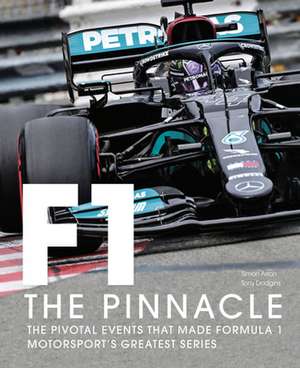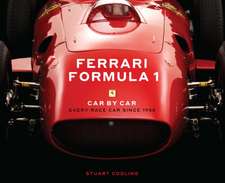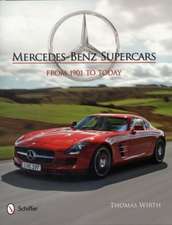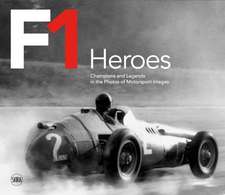Formula One: The Pinnacle: Formula One
Autor Tony Dodgins, Simon Arron, Guenther Steineren Limba Engleză Hardback – 5 iul 2022
Preț: 222.27 lei
Preț vechi: 259.36 lei
-14% Nou
42.53€ • 44.50$ • 35.33£
Carte disponibilă
Livrare economică 12-26 martie
Livrare express 26 februarie-04 martie pentru 123.85 lei
Specificații
ISBN-10: 0711274207
Pagini: 240
Ilustrații: 300+ color photos
Dimensiuni: 258 x 310 x 24 mm
Greutate: 1.63 kg
Editura: Ivy Press
Seria Formula One
Notă biografică
Originally from Altrincham, Simon Arron grew up near Oulton Park, writing and photographing club races for the local newspaper and subsequently Motoring News, until he was taken on as a full-time reporter in 1982. He has written about and photographed motor sport ever since, covering events at more than 100 venues across six continents, from Phillip Island in Australia to Le Mans, Indianapolis, Kyalami, Interlagos, Suzuka and Curaçao. He has edited several publications, including Motor Sport, Motoring News and the long-running motorsport yearbook, Autocourse. He still finds time to photograph at his beloved Oulton Park and is Motor Sport's 'Editor at Large'.
Cuprins
Chapter 1 Sporting
The World Championship Begins
'Garagistes': Britain overtakes Italy
World Championship for Constructors
National Racing Colours
Grids: Lining up 2 x 2
F1 Timing
Return of Refuelling
Two-Car Teams
The Evolution of Qualifying
Spare Cars
The End of Tyre Wars
Points Finishes
When F1 Survived Covid
Sprint Qualifying
Chapter 2 Circuits
Monaco Grand Prix
Spa-Francorchamps
Monza
Silverstone
Nürburgring Nordschleife
Hermann Tilke
F1 Night Races
Chapter 3 Technical
The Demise of Front-Engined Cars
Customer Engines: Coventry Climax
Monocoque Construction
Engine Changes
The Cosworth DFV
Skyscraper Wings
Slick Tyres
Ground Effect Cars
Telemetry
The Turbo Era
Carbon Fibre
Team Radio
Active and Reactive Suspension
Steering Wheel Evolution
Driver Aids
Reintroduction of Grooved Tyres
Wind Tunnels to CFD
The Rise of Simulators
Drag Reduction System
The Hybrid Engine Era
Chapter 4 Controversies
Driver Strike
Benetton's Fuel Fiasco
Adelaide and Jerez
Team Orders
US Grand Prix Furore
Spygate
Crashgate
Hamilton vs. Verstappen
Chapter 5 Safety
GPDA: The drivers find their voice
Permanent Barriers
Seat Belts
Fire Protection
Sid Watkins Becomes Chief Medic
Safety Cars
The Halo
Chapter 6 Personalities
Enzo Ferrari
Juan Manuel Fangio
Colin Chapman
Jackie Stewart
Jim Clark
Bernie Ecclestone
Ron Dennis
Niki Lauda
Max Mosley
Frank Williams and Patrick Head
Alain Prost
Ayrton Senna
Michael Schumacher
Ross Brawn
Jean Todt
Lewis Hamilton
Chapter 7 Commercial
Stretching the Season
Title Sponsors
FOCA vs.FISA: The battle for F1
F1 Tobacco Ban
Manufacturers Exit
Teams Threaten a Breakaway Series
Liberty Media Buy F1
Netflix: D riv e to S urv iv e
Budget CapBudget Cap
Descriere
Formula 1: The Pinnacle tracks a history of the changes which have taken F1 from its rudimentary beginnings to the exhilarating high octane spectacle it is today.
The biggest change in a generation is coming to F1 in 2022. Technical changes aimed at levelling the playing field for the teams combined with the sport's tightening budget cap will make the races closer than ever. There will be more sprint races - trialled in 2021 - and greater fan interest driven by Netflix's hugely successful 'Drive to Survive' series. So, how did we get here? How did F1 become the acknowledged 'Pinnacle of Motorsport'? Dieter Rencken has identified the 100 most significant changes to the series since its inception in 1950. Formula One is unrecognizable from its debut season, where drivers raced around on old bomber training aerodrome in Northamptonshire with oil drums to mark the corners and straw bales the only concession to safety.
New fans will welcome a complete and highly illustrated guide to the history of F1, while older fans will be able to compare their own views of what were the pivotal moments of change, in a book written by a current F1 journalist with a lifetime's knowledge of the sport.
The book will link technical progress with the personalities involved, indeed many of the swiftest changes have come about as a result of accidents or tragedies - the death of Roland Ratzenberger at Imola in 1994, the same weekend as Ayrton Senna, could have been avoided by the HANS safety device. The introduction of the halo saved Romain Grosjean's life in Bahrain last year, but only came about because of the tragic accident that claimed Jules Bianchi in Japan.
Along with changes to circuits and the technology of the cars, Dieter Rencken highlights the commercial changes and the controversies that threatened to split the sport apart - such as the threat of breakaway series proposed at various times by teams.
A must-read for completists or for those new to the sport, F1: The Pinnacle is a fascinating insight into one of the most exciting and dangerous sports in the world.




























